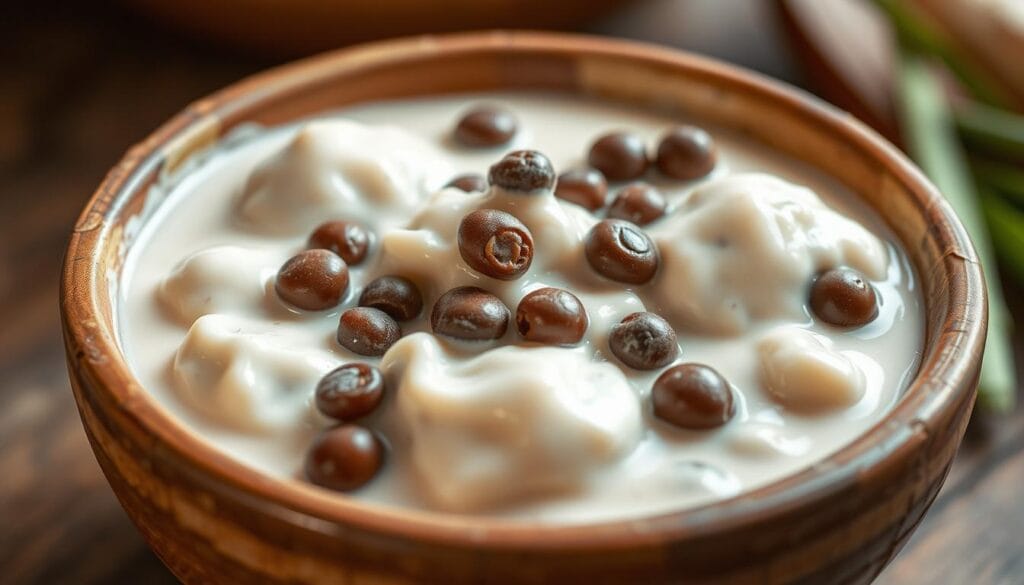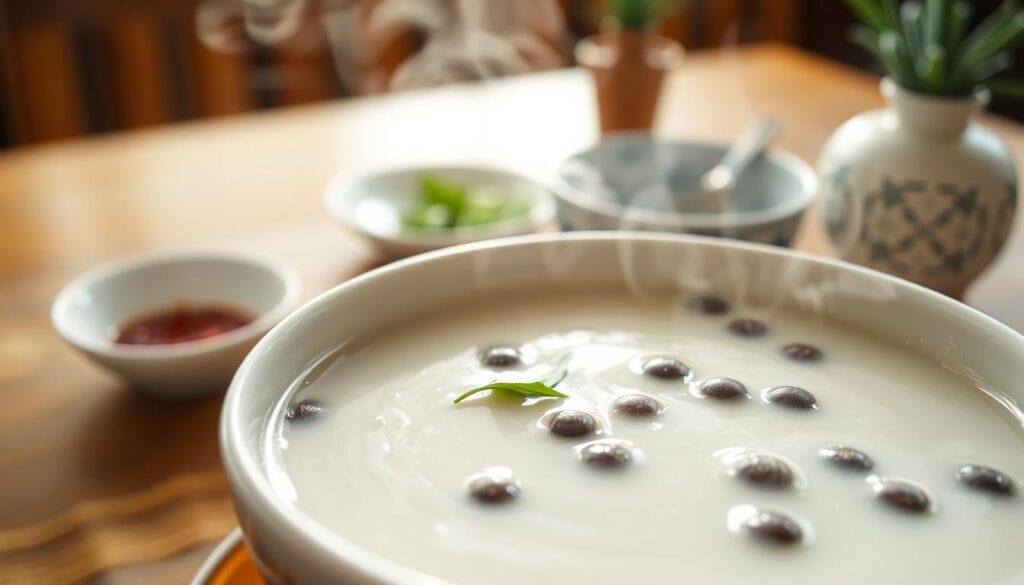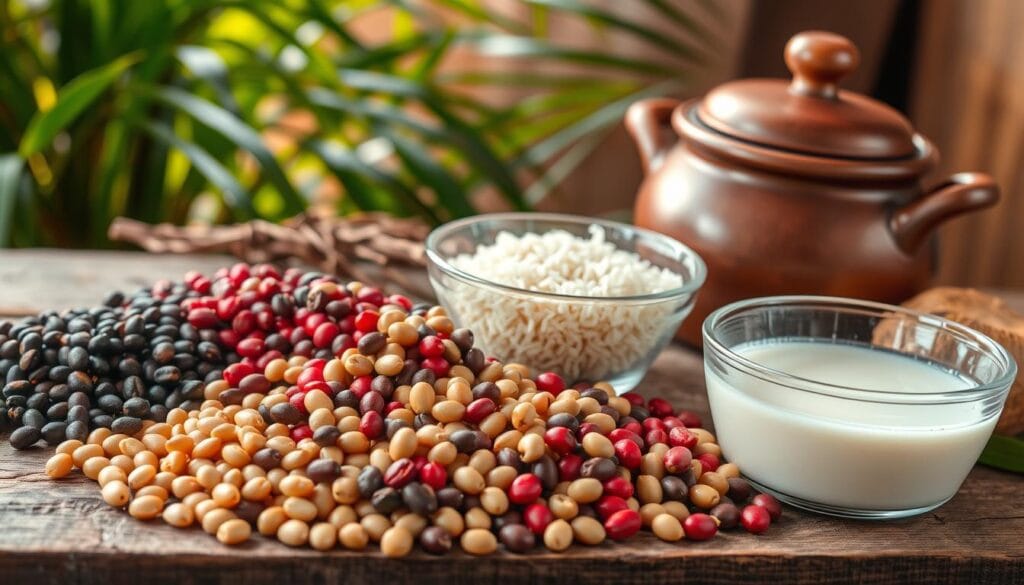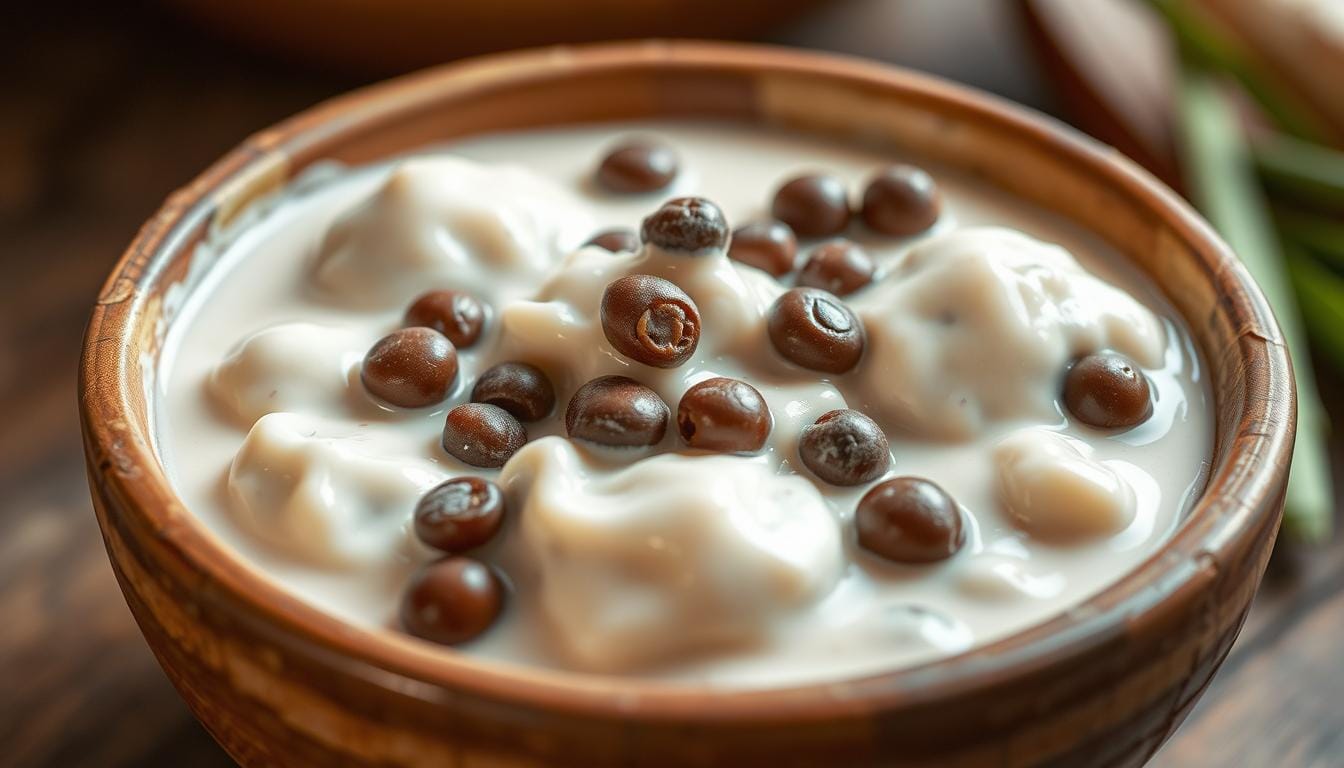How to Make Che Dau Trang – Traditional Vietnamese Sticky Rice and Black-Eyed Peas Pudding
Che Dau Trang is a beloved vietnamese sweet soup. It’s made with black-eyed peas, sticky rice, and coconut flavors. This dessert brings a taste of Southeast Asia to your table.

Key Takeaways
- Che Dau Trang combines black-eyed peas and sticky rice for a creamy, nutty texture.
- It’s a timeless vietnamese sweet soup passed down through generations.
- Popular in Vietnam as both a dessert and a soothing treat year-round.
- Easily customizable with toppings like coconut milk or tropical fruits.
- A gateway to exploring authentic Vietnamese culinary heritage at home.
What Is Che Dau Trang?
Che Dau Trang, or black-eyed pea sticky rice pudding, is a beloved vietnamese dessert soup. It combines tradition and taste in a creamy dish. Cooked black-eyed peas, glutinous rice, and coconut cream make up its base. Palm sugar adds a touch of sweetness.
It comes from northern Vietnam and is more than just a dessert. It’s a cultural symbol.

Origins and Cultural Significance
Che Dau Trang started in northern Vietnam. It’s a favorite during Lunar New Year and weddings. The black-eyed peas, called dau trang, bring good luck. Sticky rice stands for family unity.
Elders share recipes, keeping its tradition alive for generations.
Where It Fits in Vietnamese Cuisine
Che Dau Trang is unique among vietnamese dessert soups. It has an earthy black-eyed pea base. Unlike soups from the south, it balances bean richness with coconut undertones. This makes it a northern culinary icon.
Regional Variations Across Vietnam
- Northern style: Simpler preparation with minimal sugar to highlight natural bean flavor
- Southern style: Creamier with extra coconut milk and toppings like tapioca pearls
- Central variations: Some add lotus seeds or pandan leaves for aromatic complexity
These changes show how different regions shape this classic dish. They honor its historical roots.
The Sweet Legacy of Vietnamese Sweet Soups
From bustling street carts to family kitchens, vietnamese sweet soup (che) is more than a treat—it’s a cultural treasure. These desserts, often called che, blend beans, fruits, and coconut milk into cooling, layered flavors. Think of che dau, where black-eyed peas meet sticky rice in a creamy base. Each spoonful tells a story of tradition passed down through generations.

Che’s magic lies in its balance. Crunchy tapioca pearls, chewy jelly, and sweetened coconut milk create textures that delight. In the south, che dau might include lotus seeds, while northern versions often use mung beans. These variations show how regions adapt the same base into unique dishes.
“Che is a daily ritual,” says a Hanoi chef. “It’s comfort food that connects us to our roots.”
These soups aren’t just for dessert. At Lunar New Year, families serve che to symbolize good fortune. Street vendors sell them in plastic bags, while cafes present them in elegant bowls. Whether simple or elaborate, che remains a symbol of Vietnam’s vibrant food culture. Every bowl is a celebration of patience, creativity, and shared joy.
Essential Ingredients for Authentic Che Dau Trang
Making the perfect che dau co va or white bean soup needs top-notch ingredients. Each part is key to getting the right mix of sweet and texture. Let’s dive into what makes this dessert special.
Black-Eyed Peas Selection and Preparation
Choose firm, unblemished black-eyed peas. Rinse and soak them overnight. Cooking them too long makes them mushy—simmer them gently until they’re tender. Don’t use pre-cooked canned beans for the best taste.
Sticky Rice Varieties
| Variety | Texture | Best Use |
|---|---|---|
| Thai Glutinous Rice | Soft, clumpy | Classic pudding base |
| Javanica Rice | Crisp, chewy | Adds texture contrast |
Traditional Sweeteners and Flavorings
- Rock sugar: Adds molasses-like depth
- Pandan leaves: Infuse grassy aroma
- Substitute: Coconut sugar for a floral twist
Coconut Cream and Other Toppings
Use thick coconut cream (not milk) for a creamy base. Top with jackfruit jelly or roasted mung beans. Avoid watery coconut milk brands like Thai Kitchen for this step.
Asian supermarkets like 99 Ranch or H Mart carry these items. Follow these guidelines to make the che dau co va at home.
Step-by-Step Preparation Method
Learning che dau trang requires following specific steps. Here’s how to make a smooth pudding:
- Soak black-eyed peas (che dau) and sticky rice separately for 4–6 hours or overnight. Rinse and drain before cooking.
- Cook beans in a pot with water until tender but firm. Pressure cookers cut time to 15 minutes on high pressure.
- Boil rice in fresh water with pandan leaves. Stir occasionally to prevent clumping. Cook until grains swell and release starch.
- Prepare sweet syrup: simmer coconut milk, sugar, and vanilla until thickened. Add coconut cream for creaminess.
- Layer cooked rice, beans, and syrup in a dish. Chill until set. Garnish with coconut flakes or sesame seeds.
Pro tip: Test beans for tenderness by mashing a piece. Overcooking leads to mushy texture. Adjust syrup sweetness to taste—start with ¼ cup sugar and add gradually.
For a velvety finish, chill mixture 2–3 hours before serving. Avoid overmixing layers to keep textures distinct. Serve chilled for a refreshing treat.
Tips for Perfect Texture and Flavor Balance
Mastering vietnamese dessert soup like che dau nong needs focus on details. Stay away from common mistakes and adjust the recipe to your liking with these easy tips.
Common Mistakes to Avoid
- Overcooking beans: Simmer black-eyed peas until tender but still firm. Test texture after 45 minutes.
- Incorrect liquid ratio: Use 3 cups liquid per 1 cup beans. Adjust based on desired consistency.
- Skipping soaking: Soak beans 8 hours beforehand for faster cooking and better texture.
Adjusting Sweetness for American Palates
Traditional recipes use mild sweetness. For sweeter preferences:
- Start with half the sugar, then taste and add gradually.
- Swap 1/2 cup coconut cream for coconut milk to boost richness.
- Try honey or maple syrup for modern twists while keeping authenticity.
Storage and Reheating
Store leftovers in airtight containers up to 4 days. Reheat with:
- Stovetop: Add 1-2 tbsp water, stir gently to prevent clumping.
- Microwave: Heat 20-30 seconds intervals, mix between cycles.
Freeze portions in small batches. Thaw overnight and reheat with coconut cream for restored creaminess.
Che Dau Trang Variations and Similar Desserts
Discover more of Vietnam’s bean dessert world beyond Che Dau Trang. Che dau xanh, che dau den, and che dau nong show off different ingredients and methods. They showcase Vietnam’s creativity with legumes.
Che Dau Xanh (Mung Bean Sweet Soup)
Che dau xanh is made with green mung beans that become silky smooth. They’re sweet and pair well with coconut cream and pandan leaves. This dessert is perfect for summer, topped with tapioca pearls.
Che Dau Den (Black Bean Sweet Soup)
Che dau den uses black beans that soak up all the flavors. Their dark color comes from natural pigments, mixing bitter and sweet. It’s topped with lotus seeds and enjoyed all year.
Che Dau Nong (Warm Bean Dessert)
Che dau nong is served hot, often with ginger or cinnamon. It’s a cozy treat for cold weather, using mung or black beans.
Try these variations:
- Che dau xanh for summer fun
- Che dau den for its versatility
- Che dau nong for a warm evening
Learning Che Dau Trang’s ways opens up to these new desserts. Play with beans and serving temperatures to explore Vietnam’s bean dessert range.
Serving Suggestions and Pairings
Serve Che Dau Trang in clear glass bowls or cups to show off its layered texture. Enjoy it chilled as a vietnamese sweet soup on hot days. Or warm it gently for a cozy winter treat. This white bean soup is perfect for any time.
- Pair with floral teas like jasmine or chrysanthemum tea to complement its creaminess.
- Match with bold flavors: try it alongside savory dishes like pho or banh mi for a balanced meal.
- Modern twists include drizzling dark sweetened coconut cream or crushed peanuts.
“A perfect pairing respects the dessert’s delicate balance,” notes Vietnamese culinary tradition. Add fresh mango slices or lychee for tropical contrast.
Enhance visuals with toppings: sprinkle toasted sesame seeds, shredded coconut, or a dusting of pandan-infused sugar. For gatherings, arrange servings in small bowls with a dollop of coconut foam on top. Serve with a small spoon and a napkin—this white bean soup shines when presented simply yet elegantly.
Pair with coffee or spiced chai for a modern twist, or stick to traditional options like coconut milk tea. Its mild sweetness also works with light wines or herbal infusions. Adjust toppings based on the season—mint leaves in summer, cinnamon sticks in winter.
Health Benefits of Black-Eyed Peas in Vietnamese Cuisine
Discover the hidden goodness in che dau co va! Black-eyed peas, a star ingredient in che dau, offer more than sweet flavor. These legumes pack nutrients that make this dessert a nutritious treat.
- Protein powerhouse: Black-eyed peas provide plant-based protein, perfect for vegans and meat-lovers alike.
- Rich in fiber: Supports digestion and keeps you full longer.
- Natural energy boost: Folate and iron in these beans fight fatigue.
Nutritional Profile
| Nutrient | Black-Eyed Peas | Sticky Rice |
|---|---|---|
| Protein (per 100g) | 8.3g | 7.4g |
| Fiber (per 100g) | 5.4g | 1.3g |
| Folate (per 100g) | 185µg | 19µg |
Traditional Medicinal Uses
For centuries, Vietnamese folk medicine highlights:
- Black-eyed peas aid digestion when simmered in dishes like che dau.
- They’re believed to balance energy (“khí”) in the body.
- Warm versions of che dau co va are served to soothe colds or chills.
Pair tradition with science: Enjoy this dessert knowing it’s both a cultural treasure and a wholesome choice. Small tweaks like using less sugar or fresh coconut milk boost its health profile without losing flavor.
Conclusion
Che dau trang is a symbol of Vietnam’s rich food culture. It mixes tradition and flavor in every bite. This dessert soup is more than a meal; it’s a way to see Vietnam’s culture through food.
By following the steps and tips given, American cooks can make this dessert at home. They can enjoy its creamy coconut base, soft sticky rice, and the crunchy black-eyed peas.
Trying different flavors like mung bean or black bean makes it fun. Adjusting the sweetness to your taste makes it even better. This simple recipe connects people across generations and cultures.
It’s not just tasty; it’s also good for you. Che dau trang is full of fiber and protein. This makes it even more appealing.
Exploring che dau trang opens up Vietnam’s dessert world. You can try warm bean soups or coconut treats. Sharing this dish with others or enjoying it alone celebrates cultural exchange.
As kitchens in the U.S. try new flavors, this simple pudding connects people. It shows that even small dishes can bring big joy.
Want to taste Vietnam? Try making che dau trang. Its creamy texture introduces you to southeast Asian sweets. Enjoy it as a treat or a cozy winter meal. Happy cooking—and bon appétit!
FAQ
What is Che Dau Trang?
Che Dau Trang is a traditional Vietnamese dessert. It’s made with black-eyed peas and glutinous rice. It has a creamy texture and is loved for its comforting taste.
How is Che Dau Trang served?
You can enjoy Che Dau Trang warm, at room temperature, or chilled. It’s often served in glass cups or bowls. Toppings like toasted sesame seeds or coconut shavings add flavor.
What distinguishes Che Dau Trang from other Vietnamese desserts?
Che Dau Trang is special because of its mix of black-eyed peas and sticky rice. This creates a pudding-like texture. It has a unique flavor and creamy texture, unlike other Vietnamese sweet soups.
Can I make Che Dau Trang in advance?
Yes! You can make Che Dau Trang ahead of time. Store it in an airtight container in the fridge. To keep it creamy, reheat it with a bit of coconut cream or water.
What are some common variations of Che Dau Trang?
Variations include Che Dau Xanh (mung bean sweet soup) and Che Dau Nong (warm bean dessert). Each has its own flavors and textures but shares the same basic techniques as Che Dau Trang.
What health benefits do black-eyed peas offer in Che Dau Trang?
Black-eyed peas in Che Dau Trang are full of protein, fiber, and important nutrients. They’re also good for your digestive health and give you lasting energy, according to traditional Vietnamese medicine.
How do I adjust the sweetness of Che Dau Trang for American tastes?
To make it sweeter, you can add more sugar or try honey or maple syrup. Start with a little and add more until it’s just right for you.
What are some traditional toppings for Che Dau Trang?
Popular toppings include coconut cream, toasted sesame seeds, and fresh coconut shavings. You can also drizzle it with sweet syrup. These toppings make the dessert look and taste great.
Is Che Dau Trang suitable for vegetarians or vegans?
Yes! Che Dau Trang is vegetarian and can be vegan by using plant-based sweeteners and coconut cream without animal products.

